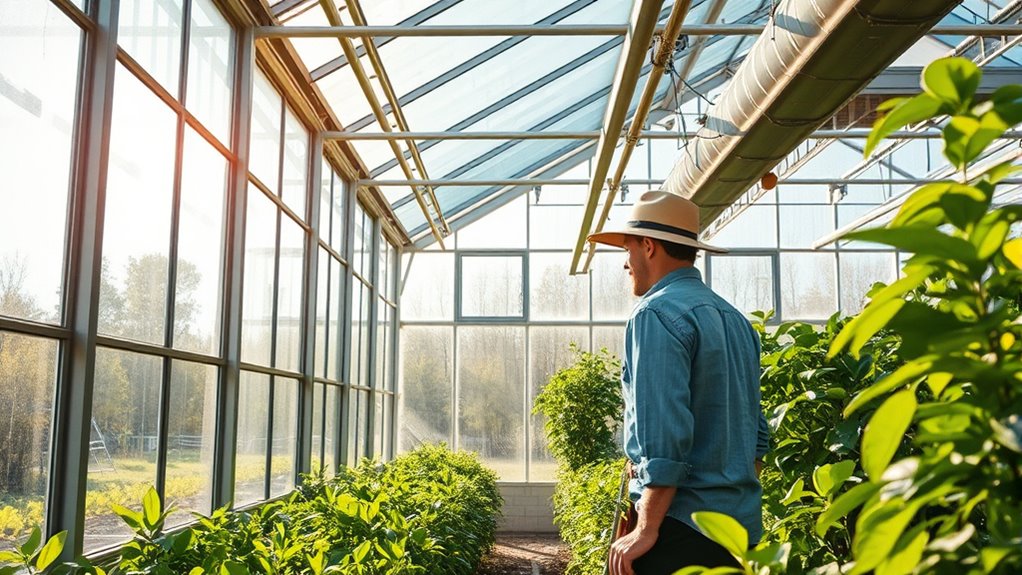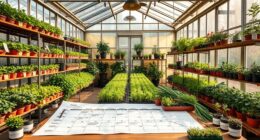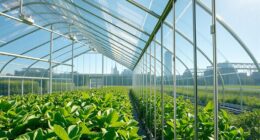If you notice poor ventilation, temperature fluctuations, persistent pests, or mold, it’s time to upgrade your greenhouse. Start by evaluating structural issues, climate control effectiveness, and pest management effectiveness. Plan your improvements by choosing durable materials, smart climate systems, and sustainable features like solar panels. Implement upgrades carefully, ensuring safety and proper testing. Maintaining your enhancements regularly will keep your greenhouse thriving. To get detailed steps on when and how to upgrade, keep exploring the essential strategies.
Key Takeaways
- Monitor signs like poor ventilation, temperature fluctuations, and pest issues to determine the right time for a greenhouse upgrade.
- Conduct thorough inspections of structure, climate systems, and pest management to assess upgrade needs.
- Plan upgrades by reinforcing structures, improving climate control, and incorporating sustainable, energy-efficient features.
- Implement upgrades carefully, following safety guidelines, testing systems post-installation, and maintaining regular equipment checks.
- Benefits include enhanced plant health, cost savings, and environmental sustainability, achieved through durable materials and smart technology integration.
Recognizing Signs That Signal It’s Time for an Upgrade
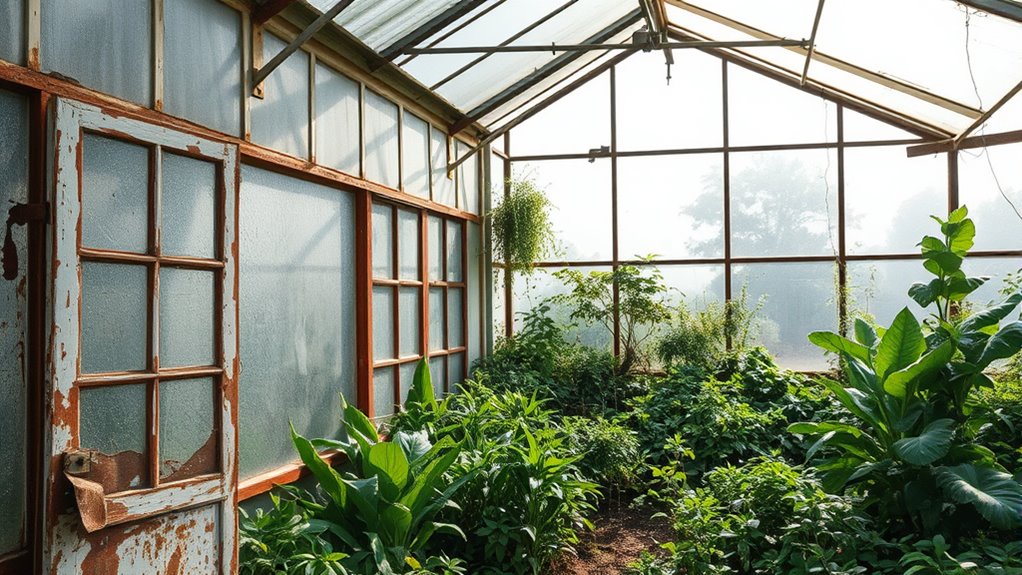
Over time, your greenhouse will show signs that it’s no longer meeting your needs or maintaining ideal growing conditions. One key indicator is poor ventilation, which can lead to stagnant air, excessive humidity, and increased disease risk. If you notice mold, mildew, or lingering odors, it’s time to contemplate ventilation improvements. Proper air circulation is crucial for maintaining healthy plant environments and preventing issues related to poor airflow. These issues often coincide with pest management challenges, as pests thrive in warm, humid environments. If pests become harder to control despite your efforts, it signals that your greenhouse’s current setup isn’t sufficient. Additionally, if temperature fluctuations become more severe or you struggle to keep conditions consistent, it’s a clear sign that an upgrade is needed. Recognizing these signs early helps you plan necessary improvements before productivity declines. Staying attentive to climate control issues ensures your plants stay healthy and productive, preventing problems from escalating. Incorporating smart home automation solutions can optimize climate regulation, making adjustments more precise and energy-efficient. Moreover, integrating sustainable materials into your greenhouse upgrades can enhance energy efficiency and environmental impact, aligning with eco-conscious practices. Using antioxidant-rich juices can also support your overall wellness as you undertake these upgrades, keeping you energized and focused on your gardening goals.
Assessing Your Greenhouse’s Current Condition and Needs

To effectively determine whether your greenhouse needs an upgrade, you should start by thoroughly evaluating its current condition and performance. Check for structural issues like leaks, damaged panels, or ventilation problems that could hinder plant growth. Additionally, assess the effectiveness of your pest management and pest control strategies; persistent pests may signal outdated methods or inadequate coverage. Proper filtration systems can help prevent pest infestations and improve overall health. It’s also important to monitor climate control systems to ensure they are maintaining optimal temperature and humidity levels, as fluctuations can stress plants. Examine the ventilation systems to see if they are functioning properly to promote healthy airflow and reduce humidity-related issues. Look for signs of wear, such as rust or broken equipment, which can reduce efficiency. Additionally, review your current setup’s ability to support your plants’ growth and productivity. Understanding symptoms of plant stress can help you identify underlying issues affecting plant health.
Planning Your Upgrade: Key Features and Improvements

To plan your greenhouse upgrade effectively, start by evaluating your current structure and identifying areas that need reinforcement or modification. Consider climate control options that will create a stable environment for your plants year-round. Don’t forget to select sustainable features that boost efficiency while reducing your environmental impact. Incorporating durable materials can enhance the longevity and resilience of your greenhouse structure. Additionally, exploring renewable resources for heating and ventilation systems can further support eco-friendly practices. Exploring Victoriana-inspired design elements can add a touch of vintage elegance while maintaining functional integrity. Understanding business hours for local suppliers can help coordinate your upgrade timeline efficiently. Incorporating glycolic acid products into your maintenance routine can also improve the longevity and appearance of your greenhouse surfaces and tools.
Assessing Current Structure Needs
Before planning your greenhouse upgrade, conducting a thorough assessment of your current structure is vital. Start by inspecting the integrity of your framing, glazing, and ventilation systems to identify any weaknesses or needed repairs. Vetted conversion kits, which are designed for reliability and performance, can serve as a model for understanding quality upgrades. Soil testing is essential to determine nutrient levels, pH balance, and drainage issues that could affect plant health. Assess your pest management history to identify persistent or new pest problems that might require updates to your control methods. Check for signs of structural wear, such as rust, cracked panels, or leaks, and evaluate whether your current setup adequately supports your plants’ needs. Incorporating space optimization techniques can help you make the most of your existing area while planning upgrades. Additionally, reviewing your automation systems can uncover opportunities to improve efficiency and reduce manual labor. Conducting a comprehensive structural inspection can reveal hidden issues that might compromise safety or performance. Exploring tuning principles from automotive upgrades can inspire innovative solutions for climate control and energy efficiency. Gathering this information helps you prioritize upgrades, whether that’s strengthening the frame, improving soil conditions, or enhancing pest control measures. A detailed assessment ensures your upgrade targets the most vital areas.
Identifying Climate Control Upgrades
Upgrading your climate control systems is essential for maintaining ideal conditions inside your greenhouse. Start by evaluating your current ventilation systems to ensure airflow is sufficient for temperature and humidity regulation. Modern ventilation options, like automated exhaust fans or sidewall vents, can improve air exchange efficiency.
Also, consider shading solutions to control excessive sunlight and prevent overheating during hot periods. Installing retractable shades or shade cloths helps maintain consistent temperatures and protects plants from sun damage. Look for systems that integrate with your existing setup for seamless operation.
Additionally, incorporating smart climate control technology can allow for more precise adjustments and remote monitoring of environmental conditions. Upgrades like advanced ventilation and shading solutions can considerably enhance your greenhouse’s climate stability, promoting healthy plant growth and optimizing productivity. Identifying these key features ensures your upgrade targets the most impactful climate control improvements.
Choosing Sustainable Features
Choosing sustainable features for your greenhouse guarantees your upgrade benefits both the environment and your operation’s long-term efficiency. Incorporate renewable energy solutions like solar panels to reduce electricity costs and lower your carbon footprint.
Additionally, installing composting systems helps recycle plant waste, enriching your soil naturally and decreasing waste sent to landfills. When selecting features, consider these key points:
- Solar panels provide clean energy, decreasing reliance on grid power.
- Composting systems turn organic waste into valuable fertilizer.
- Incorporate water-saving technology to conserve resources.
Choosing the Right Materials and Technology for Enhancement

When selecting materials for your greenhouse upgrade, consider their durability and how much they cost to guarantee long-term value.
Technology options like automated climate control or smart irrigation can make managing your greenhouse more efficient.
Balancing these factors helps you create a reliable and innovative environment for your plants.
Material Durability and Cost
Selecting the right materials for your greenhouse involves balancing durability and cost to guarantee long-term success. You need to take into account material lifespan to make sure your investment pays off over time. Conduct a thorough cost benefit analysis to compare initial expenses with potential savings on maintenance and replacements.
Key points to keep in mind:
- Durability impacts how often you’ll need to replace materials, affecting long-term costs.
- Investing in high-quality materials may have a higher upfront cost but offers better material lifespan.
- Cheaper options might save money initially but could lead to increased maintenance and replacement costs.
Technological Integration Options
Integrating modern technology with durable materials can considerably enhance your greenhouse’s performance and efficiency. Smart sensors monitor temperature, humidity, and light levels in real-time, allowing you to optimize growing conditions effortlessly.
Automation systems can control ventilation, watering, and shading, reducing manual effort and minimizing resource waste. When choosing materials, consider those that support technological integration, such as transparent plastics or glass compatible with sensor installation.
Smart sensors and automation systems work best when paired with reliable, weather-resistant materials that withstand environmental stress. This combination ensures consistent climate control, promotes healthier plant growth, and improves operational efficiency.
Upgrading with these technologies not only makes your greenhouse smarter but also more sustainable, saving you time, effort, and costs over the long term.
Implementing Upgrades Safely and Effectively

Successfully upgrading your greenhouse requires careful planning and attention to safety. Before making changes, ensure your ventilation strategies are optimized to prevent humidity buildup and promote healthy plant growth. Proper ventilation also helps control pests by reducing moist environments where they thrive.
To implement upgrades effectively, consider these key steps:
- Assess structural stability before installing new equipment or panels.
- Follow manufacturer instructions carefully to avoid accidents during installation.
- Test systems thoroughly to confirm that ventilation and pest management measures work seamlessly.
Always wear appropriate safety gear and work in well-ventilated areas. These precautions help prevent injuries and guarantee your upgrades support a healthy, pest-free environment.
Proper planning and safety awareness make all the difference in successful greenhouse improvements.
Maintaining Your Upgraded Greenhouse for Long-Term Success
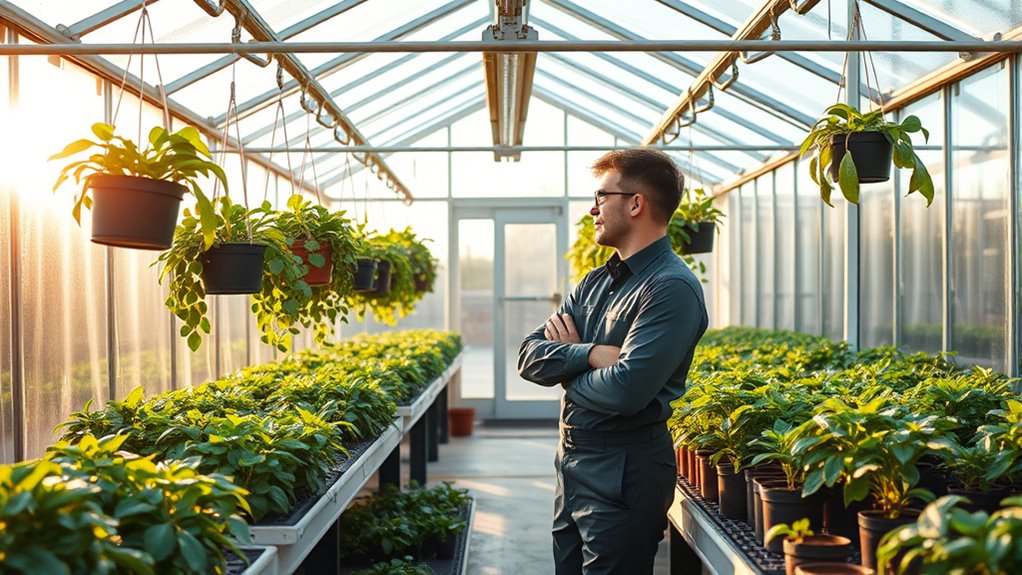
Once you’ve completed your greenhouse upgrades, regular maintenance is essential to guarantee they continue to perform at their best over time. You need to monitor plant health closely, checking for signs of stress or disease and adjusting conditions as needed.
Consistent pest management is also vital; inspect plants regularly and implement integrated pest control methods to prevent infestations. Keep your ventilation and humidity levels balanced to reduce mold and other issues that can compromise plant health.
Clean and service your equipment periodically to ensure peak operation. Staying proactive with maintenance will help identify potential problems early, saving you time and resources.
Frequently Asked Questions
How Can I Budget Effectively for a Greenhouse Upgrade?
To budget effectively for a greenhouse upgrade, start with a detailed cost analysis to understand expenses like materials, labor, and permits.
Then, explore financing options such as loans or grants to cover costs without straining your finances.
Prioritize upgrades based on your needs and available funds, and create a contingency plan for unexpected expenses.
This approach helps you stay on budget while ensuring your greenhouse gets the improvements it needs.
What Certifications or Permits Are Needed for Major Modifications?
Imagine your greenhouse as a castle that needs the king’s seal of approval before expanding. You’ll need to check building codes and secure environmental permits, like a knight seeking a royal decree.
These certifications verify your modifications meet safety and environmental standards. Before starting your upgrade, consult local authorities or a permit specialist to navigate the process smoothly, avoiding any surprises that could delay your kingdom’s growth.
How Do I Minimize Downtime During the Upgrade Process?
To minimize downtime during your greenhouse upgrade, focus on timing considerations and emergency planning.
Schedule major work during off-peak hours or seasons to reduce impact on your plants.
Prepare an emergency plan in case of unexpected delays or issues, ensuring quick response and minimal disruption.
Communicate clearly with your team and suppliers to coordinate tasks efficiently, keeping the process smooth and downtime to a minimum.
Can I Upgrade My Greenhouse Myself or Should I Hire Professionals?
You’re wondering if you should tackle the upgrade yourself or seek professional guidance. While DIY options can be tempting and cost-effective, they come with risks, especially for complex upgrades.
Consider your skills, tools, and the scope of the project. Sometimes, hiring professionals ensures quality, safety, and efficiency.
Weigh the potential challenges carefully—your greenhouse’s future hinges on making the right choice.
What Are the Best Ways to Future-Proof My Greenhouse Improvements?
To future-proof your greenhouse improvements, focus on integrating sustainable materials and automation technology.
Use eco-friendly, durable materials that withstand the test of time, reducing maintenance costs.
Incorporate automation for climate control, irrigation, and lighting to stay adaptable as technology advances.
Regularly upgrade systems and stay informed about emerging innovations.
This proactive approach guarantees your greenhouse remains efficient, eco-conscious, and ready for future challenges.
Conclusion
Did you know that a well-upgraded greenhouse can boost your crop yields by up to 30%? Regularly evaluating your greenhouse’s condition and planning strategic improvements can make a huge difference. By choosing the right materials and technology, you guarantee long-term success. Remember, proper maintenance keeps everything running smoothly. Upgrading isn’t just a one-time task—it’s an investment in your greenhouse’s future. Take action now to maximize your growing potential and enjoy healthier, more productive plants.
